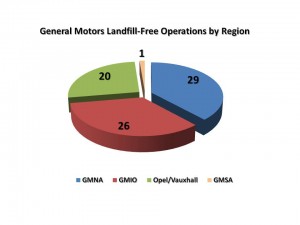General Motors has announced that it has reached its global operations commitment set in 2008 to convert 50 percent of its 145 plants to landfill-free status by the end of 2010. Currently, 52 percent, or 76 of its worldwide facilities, now take all its waste generated from normal operations and reuse, recycle or convert it to energy. GM’s first facility to achieve landfill-free status was an engine plant in Flint, Mich., in 2005.
On average, more than 97 percent of waste materials from GM’s zero-landfill plants are recycled or reused and less than 3 percent is converted to energy at waste-to-energy facilities, replacing fossil fuel use.
 “We’re committed to reducing our environmental impact,” said Mike Robinson, vice president of Environment, Energy and Safety Policy at GM. “Whether it’s a facility that’s already achieved landfill-free status or one of the many that are nearly there, every site is serious about finding ways to reduce and reuse waste.”
“We’re committed to reducing our environmental impact,” said Mike Robinson, vice president of Environment, Energy and Safety Policy at GM. “Whether it’s a facility that’s already achieved landfill-free status or one of the many that are nearly there, every site is serious about finding ways to reduce and reuse waste.”
The first step in the process for each plant was for employees to focus on reducing the amount of waste generated. From there, as much as possible, the waste was recycled. Each month, the plants monitor, measure and report on their performance against waste-reduction goals. The collected data, that originally set the stage for the landfill-free initiative, demonstrates what materials are being generated, reused and recycled, and reveals areas for improvement. Ultimately, The results helped form a process that enables all facilities to replicate best practices.
According to a GM news release, this year the company has recycled or reused 2.5 million tons of waste materials at its plants worldwide that would fill 6.8 million extended-cab pickup trucks. If parked end-to-end they would stretch around the world.
“It’s all about being creative, lean and rethinking traditional manufacturing processes,” said John Bradburn, manager of GM’s waste-reduction efforts. “When you think of what it would take for a family of four to not produce any trash for a year, that’s quite a task. This is 76 sites around the world and about 70,000 employees committed to the cause.”
Bradburn continued, “I believe our employees were willing to engage because they could relate to what it means. People don’t want to be wasteful; they want to help the environment. It’s become a sense of pride for those that work at those facilities, and it reflects in quality and throughput.”

